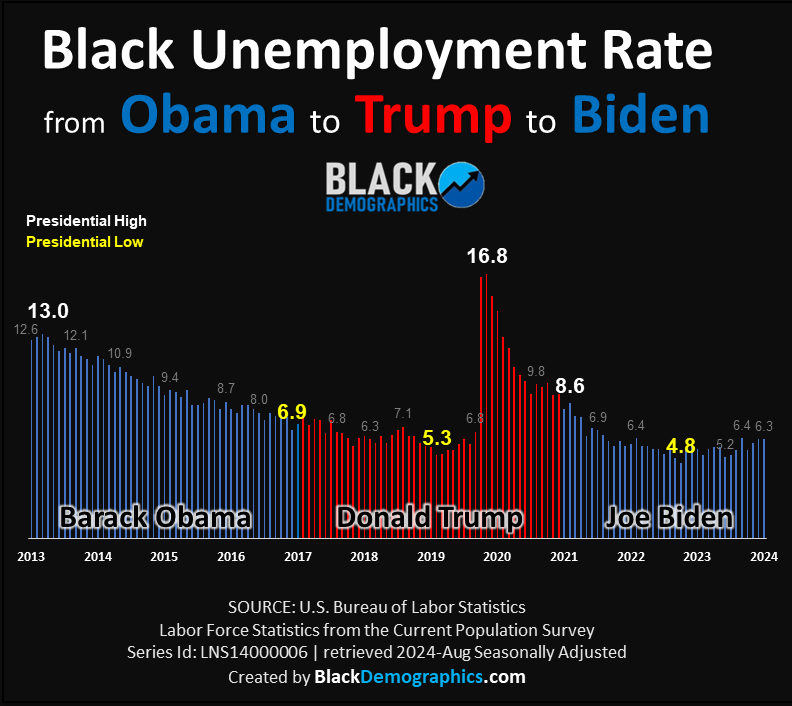Black Unemployment Rates from 2013 to 2024: A Decade in Review

The unemployment rate is a vital indicator of the economic well-being of the Black/African-American population in the United States. From 2013 to 2024, this rate has seen significant fluctuations, reflecting various economic conditions and events such as the Great Recession, the COVID-19 pandemic, and inflation. This post will provide a straightforward, non-partisan review of the Black unemployment rate during the terms of Presidents Barack Obama, Donald Trump, and Joe Biden, based on data compiled by the U.S. Bureau of Labor Statistics.
The Obama Years (2013-2016)
Elected during the beginning of the Great Recession (the largest since the Great Depression), Obama inherited a troubled economy with a sharply growing unemployment rate. Reaching a high of 13.0% in 2013, the Black unemployment rate showed a notable decline, decreasing steadily to 6.9% by the end of his second term in 2016. This period witnessed a gradual recovery from the Great Recession, with the economy improving and job opportunities increasing for Black Americans.
The Trump Years (2017-2020)
Under Donald Trump’s administration, the Black unemployment rate initially continued its downward trend, reaching a historic low of 5.3% in 2019. However, the unforeseen COVID-19 pandemic in 2020 caused a dramatic spike, pushing the rate up to 16.8%. The latter part of Trump’s term focused on addressing the economic fallout from the pandemic, with the rate beginning to decline again as recovery efforts took hold.
The Biden Years (2021-2024)
Joe Biden’s presidency began with the challenge of navigating the ongoing economic recovery from the pandemic. The Black unemployment rate started at a high of 8.6% in 2021 when he took office but generally trended downward, reaching a new historic low of 4.8% in 2022. As of August 2024, the rate is 6.3%, indicating some variability but an overall move towards stabilization.
Observing the Trends
The fluctuations in the Black unemployment rate over the past decade highlight its sensitivity to broader economic conditions and external events. While these rates changed during the terms of different presidents, they were influenced by a range of factors, including economic cycles and significant events like the COVID-19 pandemic.
- 2013-2016: A period of recovery from the Great Recession, with unemployment steadily decreasing.
- 2017-2020: Continued decline in unemployment until the pandemic caused a sharp increase.
- 2021-2024: Focus on post-pandemic recovery, with unemployment rates showing signs of improvement and stabilization.
Conclusion
The Black unemployment rate from 2013 to 2024 reflects a decade of economic challenges and recoveries. By reviewing these trends, we can get a bigger picture of the economic experiences of Black Americans. For more detailed analyses and data, visit BlackDemographics.com.

